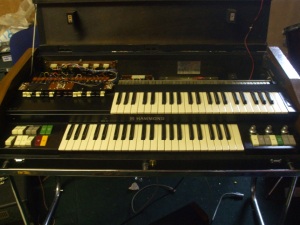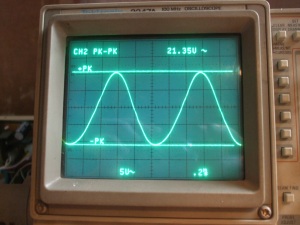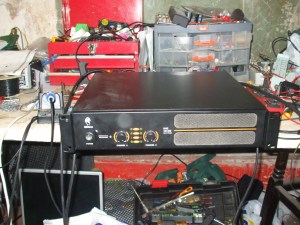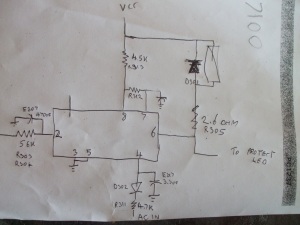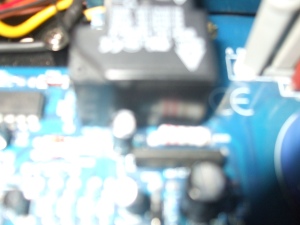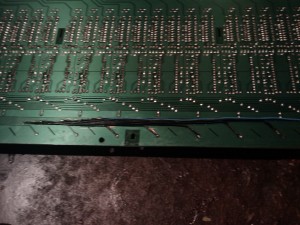This Hammond X5 came to me with various issues that are common with these old organs and sometimes unless you have a lot of spare time on your hands are not economical to repair. This particular example would probably come under that bracket but me being me I decided that I’d give it a go.
The organ would only make horrible noises when it was dropped off for the repair that was a new issues that wasn’t on the to do list before I had even started. I sounded all distorted and sometimes would suddenly sound alright for a split second. This beings as it had only just been transported smacked of a bad connection but no amount of wiggling connectors especially the ones from the amp and volume pedal did nothing. So I started tapping on thing to see if I could aggravate the issue and as soon as I tapped on top of the amp that is house in the pedal board assembly in sound would jump back every time I tapped. So out came the pedal board.
As you can see the pedals are on the left. The volume pedal is in the middle and the silver box to the right is the amplifier (The amplifier is a solid state in the X5.). After opening the amplifier cover I could immediately see that I wasn’t the first person here. Not surprising given the age of the instrument.
Here you can see the large transformer to the left, the bridge rectifier in the upper middle, large reservoir caps to the upper right and main power amp module with the PCB attached to a heat sink. As the problem was most likely a cold solder joint I started with a quick inspection. There were lots of joints that looked suspect which kind of got me a bit worried about the condition of the rest of the organ.
My plan of attack here was a more of a shotgun approach as every joint looked suspect. I soldered all of the joints and was kind of confident that it would solve the issue and luckily it did. Due to the solder looking bad it will probably stop the organ from developing a problem further down the line. I tested the amp with a 1kHz sine wave and all looked good.
Ignore the tiny bits of distortion and voltage as I’m sure this was done unloaded and was really just to see if the amp was working.
Now with the amp plugged back into the organ the other host of problems became apparent. Here’s the list I wrote down at the time (please note I don’t play organ and some of my terminology make be incorrect).
- The volume pedal was very twitchy. I put that down to a bad pot, but it wasn’t as you’ll see later.
- Half the key wouldn’t work
- Percussion on the pedals made awful noises if and when present
- There didn’t seem to be and difference in note on the keys that worked
- Sometimes it would make a god awful bang.
Now with all that said these were just the ones I wrote down at the time and didn’t really cover anything such as cosmetics or noisy controls but gave me a plan of attack to get the organ somewhat useable first.
My next job was the pedal as it was still exposed and ready to work on, hence why it made the top of the list.
Here we can see the pedal without its rubber cover as I was trying to save time getting to the potentiometer to clean it but was slowly beginning to realise it didn’t have one.
What the X5 uses is a bulb and an LDR (light dependent resistor) to gauge the position of the pedal by using a slit that has a blocking plate that moves in front of the LDR to adjust the amount of light it sees from the bulb. I pulled out the bulb to make sure it was seated in its holder and this happened.
Now the bulb didn’t seem too secure, but if the loose wire was the issue then I’m not sure. After re-attaching the wire and a quick once over of all the joints with fresh solder it seemed fine and was working once again. I gave the entire board a quick clean up and made a nice new shroud for the pedal out of card. I think it may also have a part to play as the light was getting in and the bulb was not working. Here is a picture of the old shroud.
I didn’t get a pic of the new one, but I’m sure we can all use our imagination and accept that I did an awesome job and it didn’t look like a one year old did it honest.
Anyway I’ll leave this here and come back with a part two as this one is going to be long and me having to remember every detail is also an issue here.
See you later for part two where it all gets a bit mad and I add a bit of a twist provided by FlatKeys.
